全文HTML
--> --> -->Ce基合金由于其良好的固溶性, 是核武器关键材料钚(Pu)潜在的替代品, 由于目前的国际规则, 并不能对Pu进行直接的实验研究, 因此Ce基合金作为其潜在的替代品成为了研究的热点. 目前已有****对Ce-Th, Ce-La, Ce-La-Th合金的物理性质进行了一系列的理论预测与实验测量, 主要关注同构相变的信息. Lawson等[7]用实验测得了Ce0.9Th0.1存在γ—α同构相变. Lawrence等[8]测量了温度在4.2—300 K区间、压强在0—12 kPa区间时不同组分Ce0.9-xLaxTh0.1体系(x = 0.10, 0.11, 0.14, 0.17)的电阻率变化情况, 以此确定了Ce-La-Th合金的γ—α同构相变的压强温度边界. Drymiotis等[9]实验测量了Ce0.8La0.1Th0.1中γ—α相变中伴随的外加磁场变化, Ruff等[10]通过X射线衍射实验证实了Ce0.8La0.1Th0.1也存在体积塌缩的同构相变. 目前对于Ce基合金高压相变的研究较为匮乏. 我们前期用第一性原理计算了CexTh1–x合金体系的结构相变随组分的变化规律[11], 发现fcc-bct相变压强随Ce组分的增加而减小, 也即随着Th的加入, 提高了合金的相变压强. 我们采用密度泛函理论结合准谐近似对两种不同组分的Ce-La合金的相变及状态方程(EOS)进行了研究[12], 发现在压力的作用下, Ce-La合金从fcc结构转变到bct结构, 而在fcc结构中, 又有γ—α同构相变发生. 本文分别计算了两种不同组分的Ce-La合金(Ce0.875La0.125和Ce0.963La0.037)的相变压强, 结果表明随着La含量的增加, 相变压强升高. 高压环境下对Ce-La-Th体系的科学研究还较为匮乏, 本文对Ce0.8La0.1Th0.1在压力下fcc-bct的相变情况和热力学性质进行了研究讨论.
3.1.结构相变
我们计算了Ce0.8La0.1Th0.1合金fcc相及bct相的能量-体积关系, 获得了其各自的状态方程. 得到的fcc相及bct相在0 GPa, 0 K下的平衡体积V0, 体积模量B0的数据如表1所列, 同时表中也列出了Ce0.875La0.125及纯Ce的理论值和实验值作为参照. Ce0.8La0.1Th0.1合金bct相的平衡体积V0 = 28.91 ?3, 体积模量B0 = 35.96 GPa. 随着La, Th的加入, 相对于纯Ce而言, 平衡体积V0增加, 而体模量B0减小. 随着Th的加入和La成分的减少, Ce0.8La0.1Th0.1合金的体模量略大于Ce0.875La0.125合金.| V0/?3 | B0 / GPa | ||
| Present | Ce0.8La0.1Th0.1 | 28.91 | 35.96 |
| Calc.[12] | Ce0.875La0.125 | 28.00 | 32.50 |
| Calc. | Pure Ce | 27.07[6], 24.7[22] | 41.72[6], 48.4[22], 37[23] |
| Expt. | Pure Ce | 29.0[20], 28.06[24] | 20[20], 35.0[25] |
表1零温零压下fcc相Ce-La-Th合金的平衡体积(V0)及体积模量(B0)
Table1.Equilibrium volume (V0) and bulk modulus (B0) of Ce-La-Th of fcc phase at 0 GPa and 0 K.
对Ce0.8La0.1Th0.1合金的fcc—bct相变进行计算和分析, 将得到的fcc相和bct相的体积-压强关系, 与纯Th[19]、纯Ce[20]、Ce0.76Th0.24[21]及Ce0.875La0.125[12]的数据进行比对, 如图1. 本文的数据与已有的Ce基合金及纯Ce的体积-压强变化的规律相吻合.
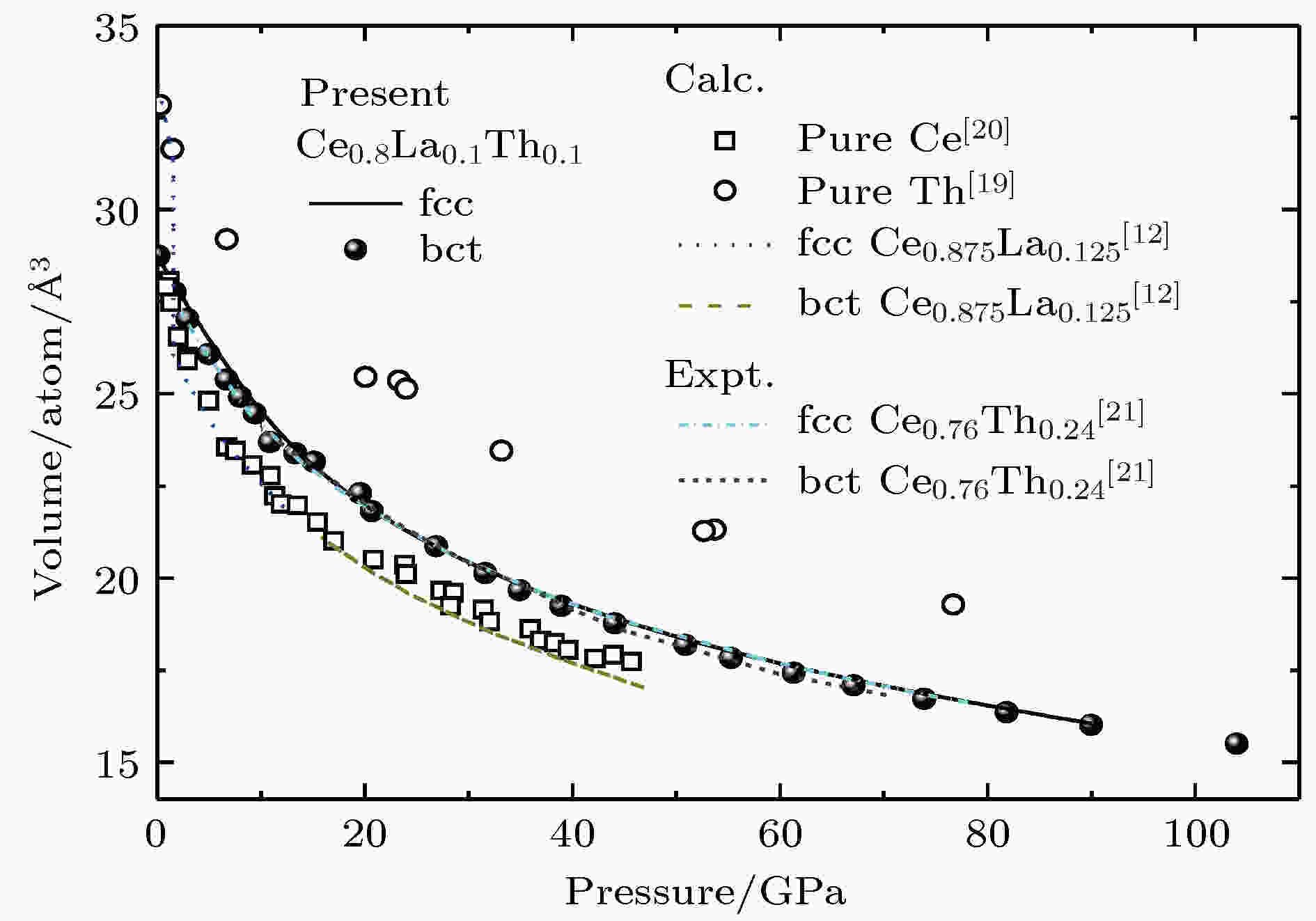 图 1 体积随压强变化的规律(黑色实点为直接加压结构优化后的结果, 黑色实线为状态方程拟合结果), 并与已有的Ce[20], Th[19], Ce0.875La0.125[12]的计算值及Ce0.76Th0.24[21]实验值进行比较
图 1 体积随压强变化的规律(黑色实点为直接加压结构优化后的结果, 黑色实线为状态方程拟合结果), 并与已有的Ce[20], Th[19], Ce0.875La0.125[12]的计算值及Ce0.76Th0.24[21]实验值进行比较Figure1. The EOS of fcc and bct Ce-La-Th together with the experimental data (the black solid point is the result of the structure optimization, the black solid line is the fitting result of the EOS), together with the experimental data for Ce0.76Th0.24[21] and the calculated results for Ce[20], Th[19], Ce0.875La0.125[12].
通过对总能的计算结果表明, fcc和bct两种相结构之间焓的差异非常小, 几乎接近计算误差值, 这意味着不能再通过比较焓变的差异来判断相变压强.
对bct相固定体积进行结构优化, 晶格常数的计算结果如图2所示. 随着体积的减小, 当体积减小至20.14 ?3时, 晶格常数a, c的线性规律发生变化, 这意味着晶体结构出现了变化, 相变开始发生. 计算得到的轴向比c/a与已有的Ce0.76Th0.24[21], Ce[6], Th[11], Ce0.875La0.125[12]数据进行了对比. 当压强小于31.6 GPa时, c/a的值约等于, 随着压强的增加, fcc相变得不稳定, 开始向bct相转变. 在34.9 GPa附近时, bct相趋于稳定 c/a的值约等于1.65, 与我们前期计算得到的CeTh, CeLa合金的fcc相, bct相的c/a的值在误差范围内吻合[11, 12].
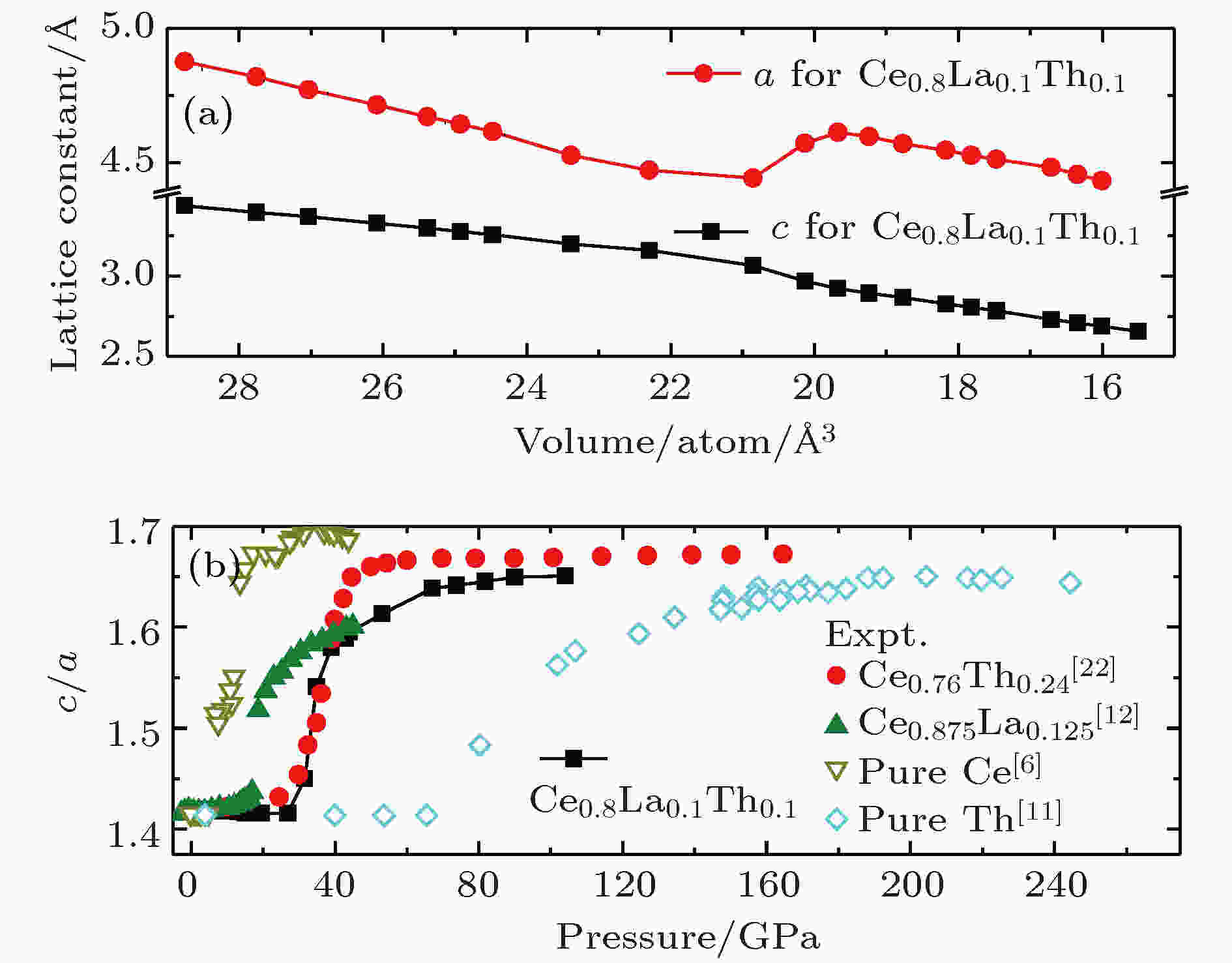 图 2 (a) 晶格参数随体积的变化关系; (b) 轴向比c/a随压强的变化关系, 并与已有的Ce0.76Th0.24[21]实验结果和Ce0.875La0.125[12]、纯Ce[6]、纯Th[11]计算结果进行比较
图 2 (a) 晶格参数随体积的变化关系; (b) 轴向比c/a随压强的变化关系, 并与已有的Ce0.76Th0.24[21]实验结果和Ce0.875La0.125[12]、纯Ce[6]、纯Th[11]计算结果进行比较Figure2. (a) Lattice constants a and c of Ce0.8La0.1Th0.1 as functions of volume; (b) the calculated axial ratio (c/a) of bct phase as functions of pressure.
2
3.2.弹性性质
本文计算了Ce0.8La0.1Th0.1合金fcc相及bct相结构的弹性性质, 在不同压强下的弹性常数如图3所示. 对于fcc相而言, 随压强增加, 所有的弹性常数都是线性增加的. 弹性常数C11, C44在相变压强附近开始出现非线性的变化. 对bct相而言, 在压强增加的变化趋势下, 越过相变压强后弹性常数线性增加的趋势变得更加明显. 根据弹性常数, 能够计算出多晶的弹性模量, 对于Ce0.8La0.1Th0.1合金, 多晶的弹性模量(剪切模量G、体模量B和杨氏模量E )能够根据Voigt-Reuss-Hill近似得出.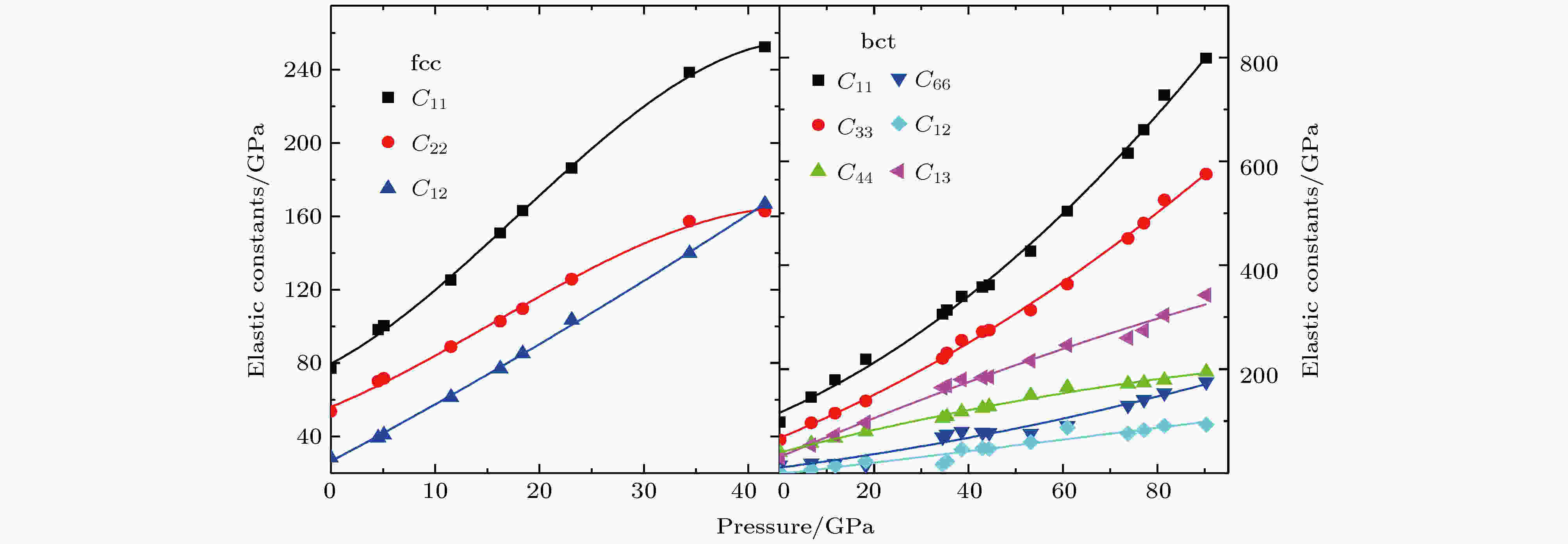 图 3 Ce-La-Th合金fcc相及bct相弹性常量随压强的变化
图 3 Ce-La-Th合金fcc相及bct相弹性常量随压强的变化Figure3. Elastic constants as functions of pressure.
如图4所示, 随着压强的增加, 弹性模量呈线性增加的趋势, 而杨氏模量E和剪切模量G则在相变压强附近出现“变软”的趋势; 随着相变的完成, 新相趋于稳定, 杨氏模量E和剪切模量G随压强增加的关系再次趋于线性. 通过弹性模量,能够计算德拜温度. 如图5所示, 在0 GPa压强下, Ce0.8La0.1Th0.1合金的德拜温度为228.85 K, 高于纯Ce已有的德拜温度研究值[26, 27]. 根据已有的研究[12], 德拜温度随着La组分的增加而增加, Ce0.875La0.125在零温零压下德拜温度为140.9 K, 遂认为在Ce0.8La0.1Th0.1合金中, La和Th元素的掺杂导致了德拜温度的升高, 原子间作用力也会因此升高, 本文的计算结果是合理的. 在大约34.4 GPa时, fcc相德拜温度随压强增加呈减小的趋势, 而bct结构与fcc结构的德拜温度十分接近, 并随压强增加呈线性增加的趋势. 意味着结构相变开始发生, 在41.6 GPa附近, fcc结构转变为bct结构, 此时德拜温度为330 K.
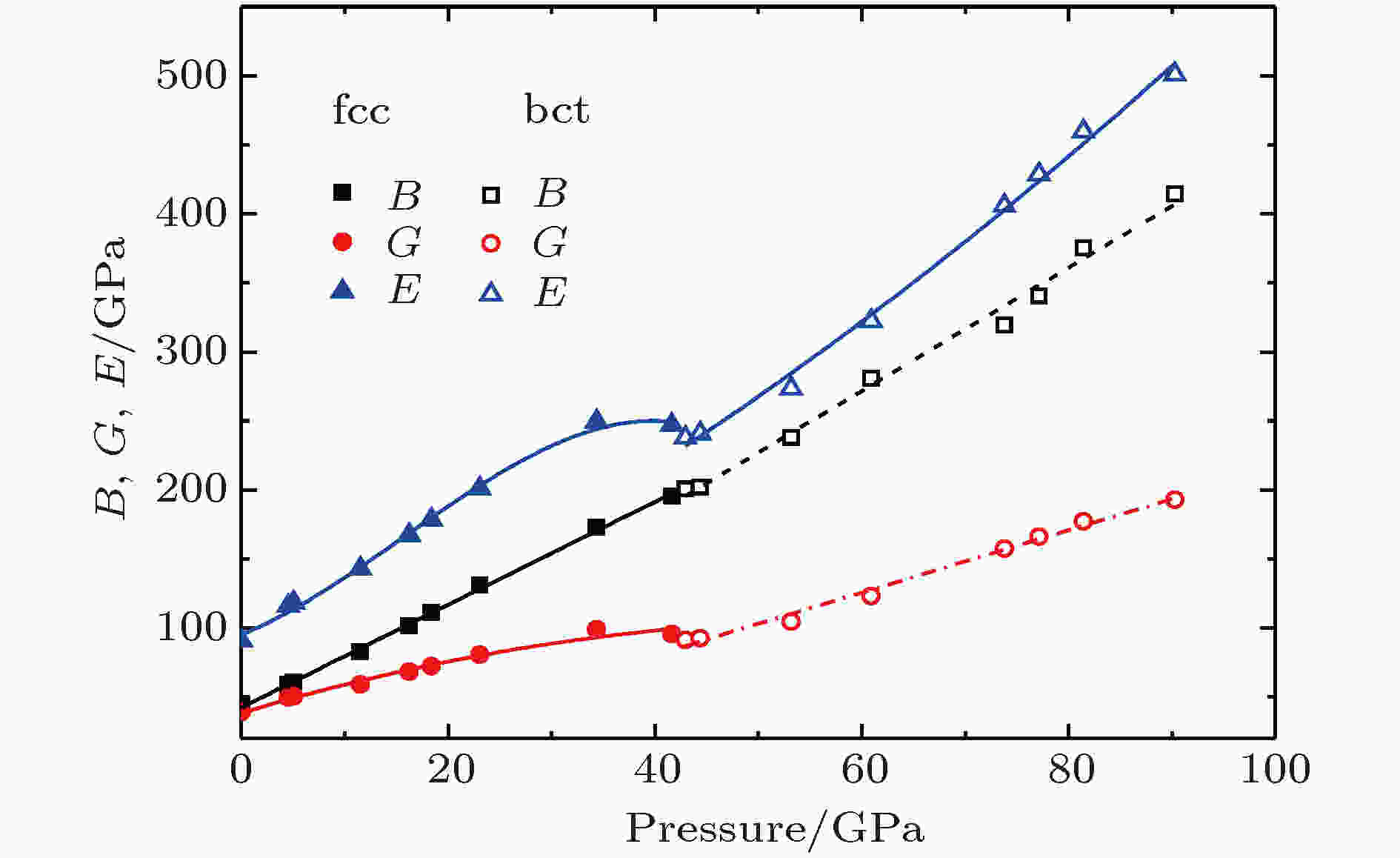 图 4 剪切模量G、体模量B和杨氏模量E随压强的变化
图 4 剪切模量G、体模量B和杨氏模量E随压强的变化Figure4. Shear modulus G, bulk modulus B and Young′s modulus E as functions of pressure.
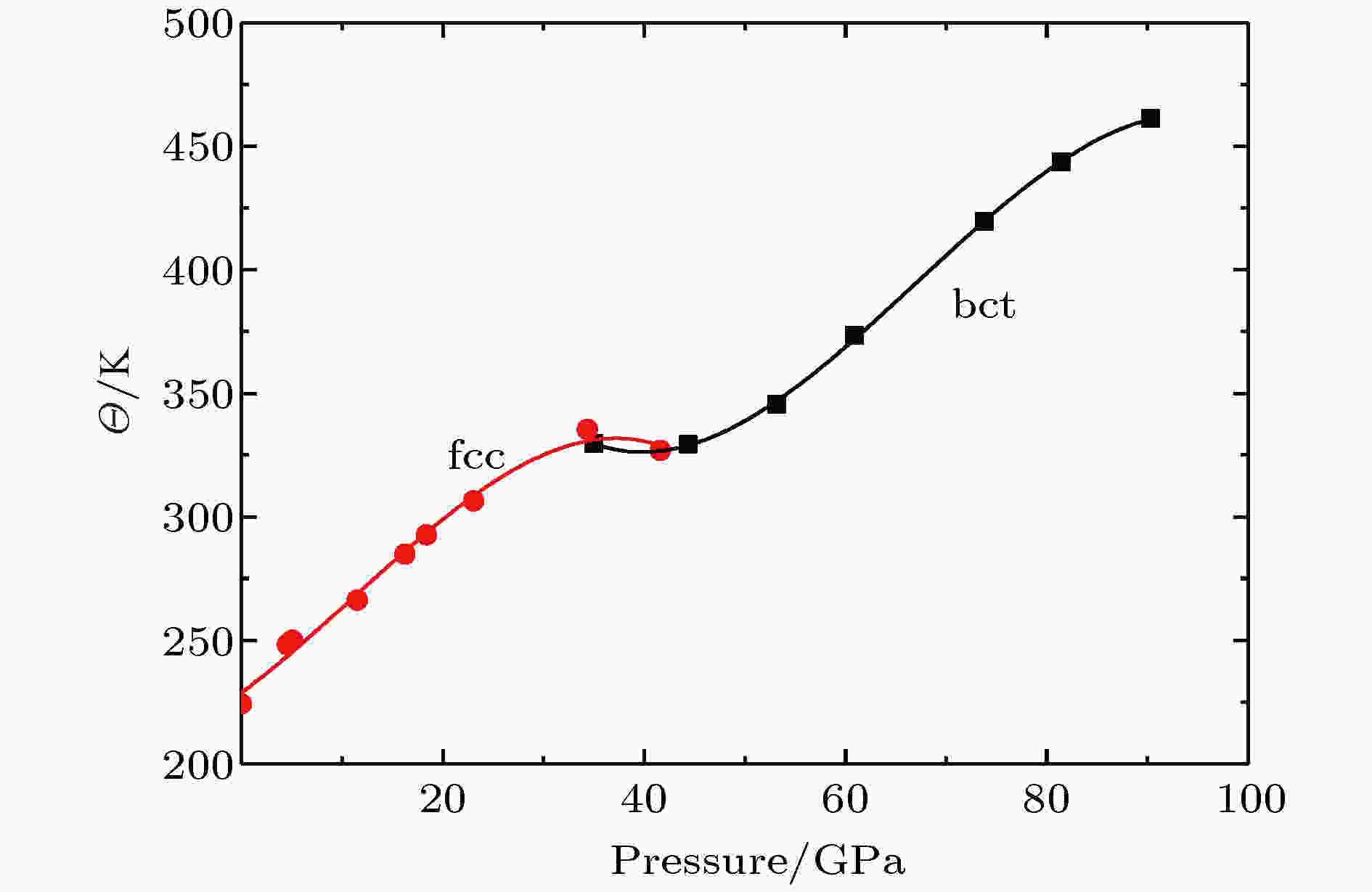 图 5 德拜温度随压强的变化
图 5 德拜温度随压强的变化Figure5. The Debye temperature as a function of pressure.
2
3.3.热力学性质
利用准谐德拜模型获得了Ce0.8La0.1Th0.1的热力学性质和不同温度下的等温压缩曲线. 如图6所示, 当温度为300 K, 压强从0 GPa上升到40 GPa时, fcc相体积缩小了约34.6%. 而在零压下, 当温度从300 K上升到1000 K时, fcc的体积膨胀了约11.1%. 高压状态下温度对体积的影响逐渐减小, 高温的非谐效应在压力的作用下被抑制. 当压强大于40 GPa时bct相稳定存在, 当温度为300 K, 压强从40 GPa上升到80 GPa时, bct 相体积缩小了约13.9%, 而在零压下, 当温度从300 K上升到1000 K时, bct相体积膨胀了约8.2%.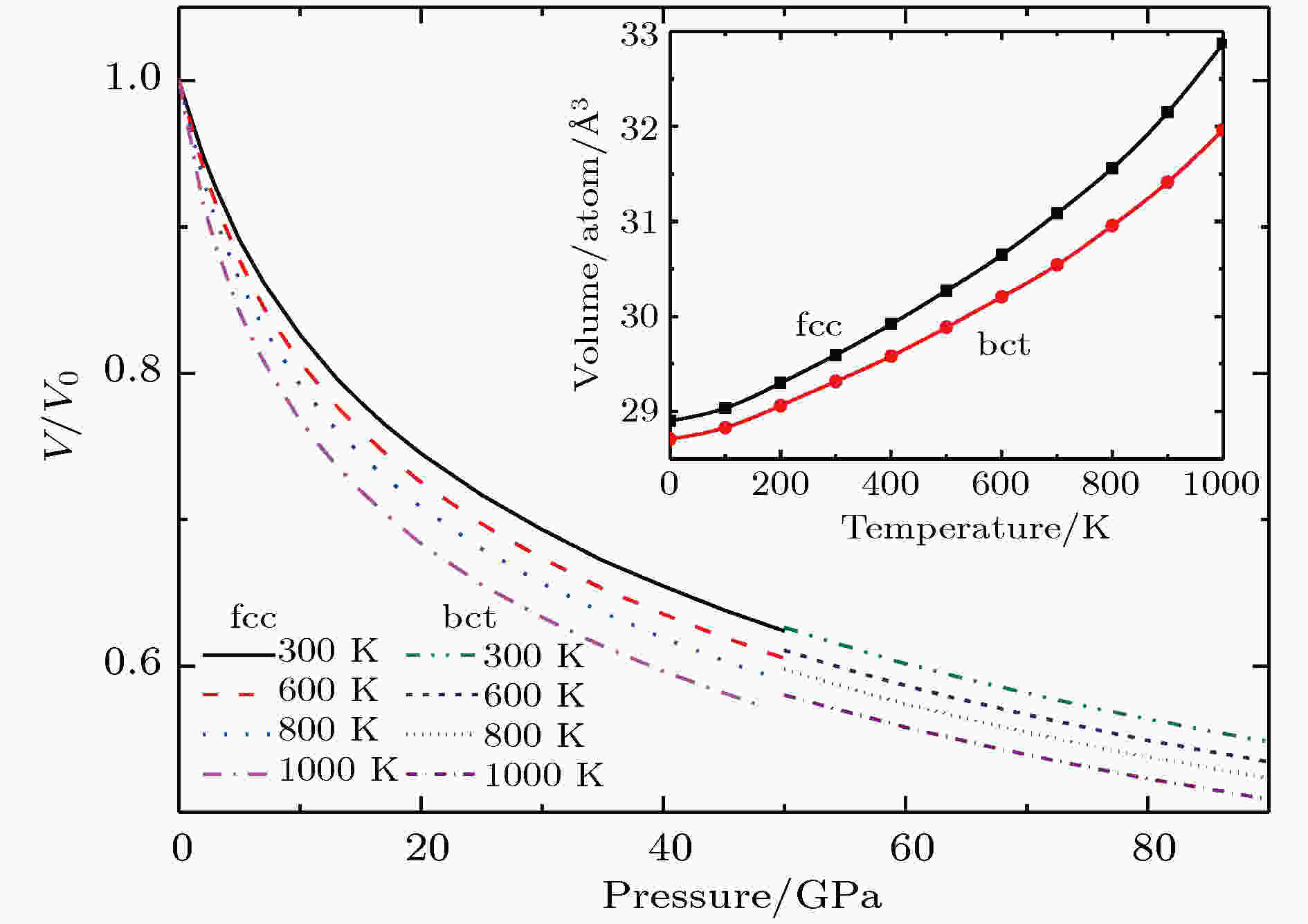 图 6 不同温度下的等温线, 其中V0为零温零压下的体积, 小图为零压下体积随温度的变化
图 6 不同温度下的等温线, 其中V0为零温零压下的体积, 小图为零压下体积随温度的变化Figure6. Isotherms at different temperatures, where V0 is the volume at zero temperature and zero pressure; the volumes at zero pressure as functions of temperature (the insert) .
分别计算了fcc相和bct相定容热容CV随温度和压强变化的关系, 以及熵S随温度和压强的变化关系. 如图7所示, CV随着温度升高迅速增加, 在高温下接近25 J/(mol·K)的极限, 热容在不同温度下随压强的变化情况几乎是单调递减的. 当温度超过600 K后, 不同等温线之间的差距变小. 计算得到在常温常压下的熵值约为49.44 J/(mol·K), 随温度的升高, 熵值几乎迅速单增, 在不同的温度下, 熵值随压强的增加而减小.
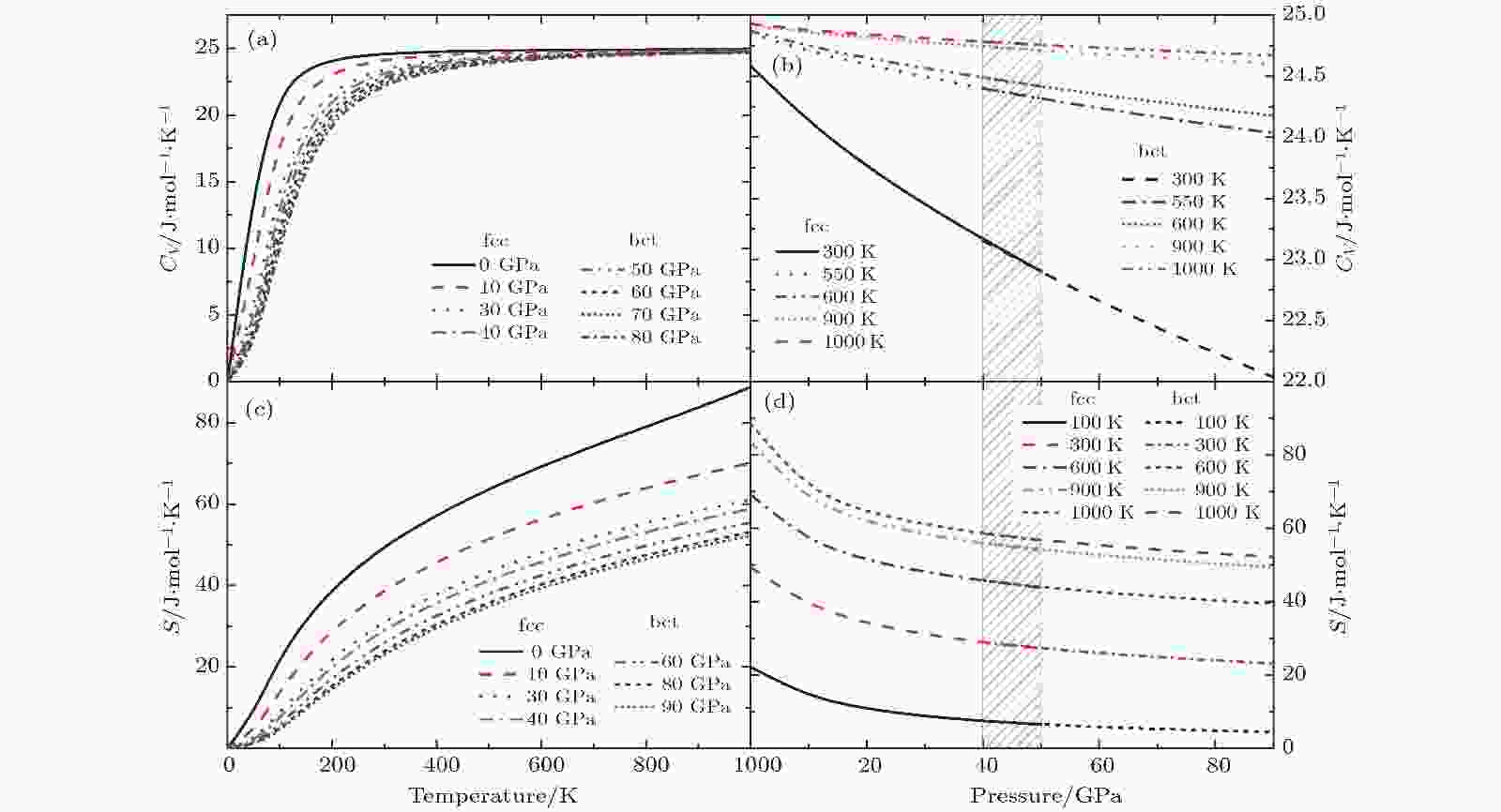 图 7 定容热容CV随温度(a)和压强(b)的变化, 以及熵S随温度(c)和压强(d)的变化; 图中阴影区域包含fcc和bct两相的数据
图 7 定容热容CV随温度(a)和压强(b)的变化, 以及熵S随温度(c)和压强(d)的变化; 图中阴影区域包含fcc和bct两相的数据Figure7. The constant volume heat capacity CV versus temperature (a) and pressure (b), and the entropy S versus temperature (c) and pressure (d).

